games103——作业1

实验一主要实现简单的刚体动画模拟(一只兔子),包括 impulse 的碰撞检测与响应,以及 Shape Matching方法。
完整项目已上传至github。
文章目录
- 简单刚体模拟(不考虑碰撞)
-
- 平移运动
- 旋转运动
- 粒子碰撞检测与响应
-
- 碰撞检测
- 碰撞响应
-
- Penalty Methods
-
- Quadratic Penalty Method
- Quadratic Penalty Method with a Buffer
- Log-Barrier Penalty Method
- Impulse Method
- 刚体碰撞检测与响应
-
- 碰撞检测
- Impulse方法的碰撞响应
- 作业代码与提高项
-
- 作业代码
- 提高项
简单刚体模拟(不考虑碰撞)
物体在场景中的位置由其平移矩阵,以及旋转矩阵决定(刚体不能形变,所以不需要缩放矩阵)。
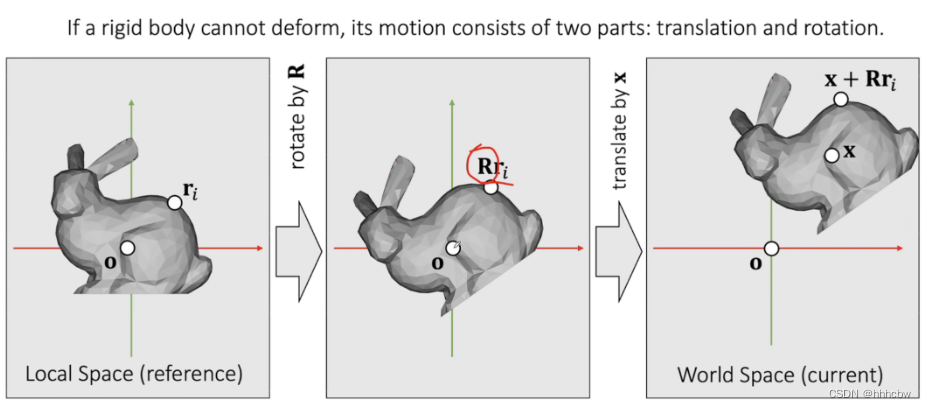
平移运动
对于平移运动,状态变量(state variable) 包括位置 x 和 速度 v,其正常更新如下

但这个积分没法在计算机内直接求,可以使用数值积分的方法进行运算,比如显式积分和隐式积分
- 显式积分

- 隐式积分
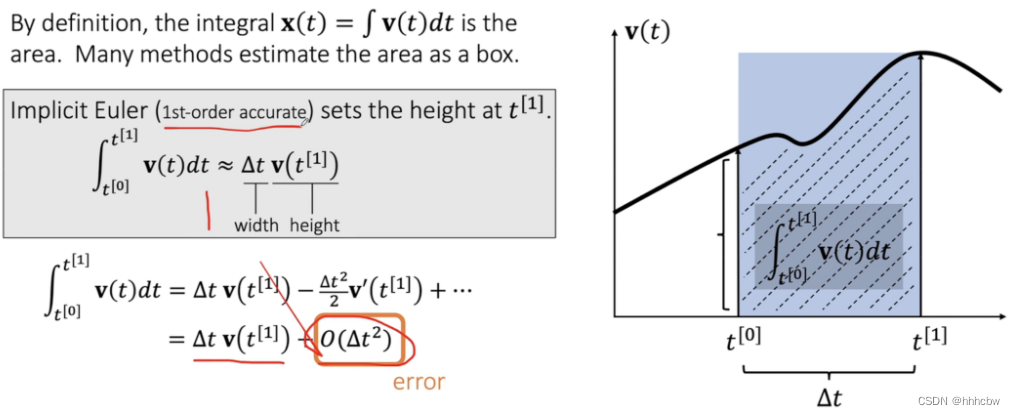 这里我们采用 Leapfrog Integration 方法,其在速度的更新上采用显式积分,而在位置的更新上采用隐式积分。
这里我们采用 Leapfrog Integration 方法,其在速度的更新上采用显式积分,而在位置的更新上采用隐式积分。

那么在仿真过程,平移运动的更新过程如下,这里的 △t\\triangle t△t 为用户指定的变量。

在 lab1 中的对应代码如下,这里只考虑了重力,linear_decay表示速度的衰减系数,比如空气阻力等。
// Part I: Update velocities
v += dt * gravity;
v *= linear_decay;
//Update linear status
Vector3 x = x_0 + dt * v;
旋转运动
旋转运动在仿真中一般使用矩阵、欧拉角以及四元数表示,对于矩阵与欧拉角都有一定的缺点,这里主要使用四元数(当然它们能互相转换)。
我们选择四元数 q 表示朝向,即从局部坐标转化为全局坐标。再使用一个3D向量 ω⃗\\vec{ \\omega }ω 表示角速度(angular velocity)。
- ω⃗\\vec{ \\omega }ω 的方向为旋转轴的方向
- ω⃗\\vec{ \\omega }ω 的大小为角速度的大小
这里引入力矩,其表示如下。与力的作用会改变平移速度相同,力矩会改变角速度。
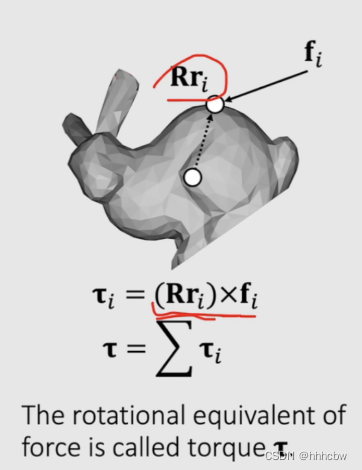
我们知道动量表示为 P⃗=mv⃗\\vec {P}=m \\vec{v}P=mv,而角动量表示为 L⃗=I×ω⃗\\vec{L} = I \\times \\vec{ \\omega }L=I×ω 这里的 III 为一个3x3的矩阵,称为惯性张量,其描述了物体中的相对于质心的的质量分布,其可以如下表示。我们把刚体看作很多粒子(质点)组成的质点系,这里的 rir_iri 表示该粒子(质点)在局部系中的位置,mim_imi 表示该质点的质量,RRR 表示旋转矩阵,即将局部系转为全局系的矩阵,其可以由四元数q转换得到。这里先求出一个 IrefI_{ref}Iref 的目的是其可以在仿真开始前就计算出来,仿真过程中只需要计算 I=RIrefRTI = RI_{ref}R^TI=RIrefRT 即可,减小计算开销。
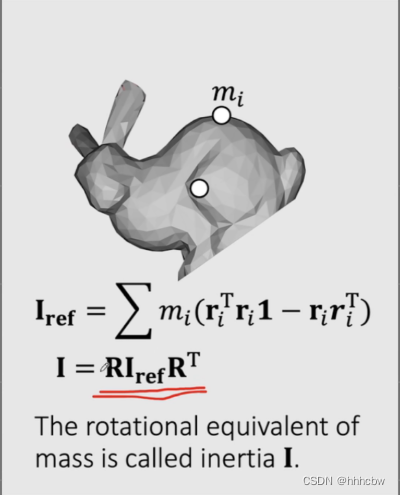
与 P⃗\\vec {P}P 的微分表示力类似,L⃗\\vec{L}L 的微分表示力矩τ\\tauτ。且 L⃗\\vec{L}L 的微分也可表示为 I×β⃗I \\times \\vec{\\beta}I×β 的形式,这里的 β⃗\\vec{\\beta}β 表示角加速度。那么仿真过程中角速度的更新如下
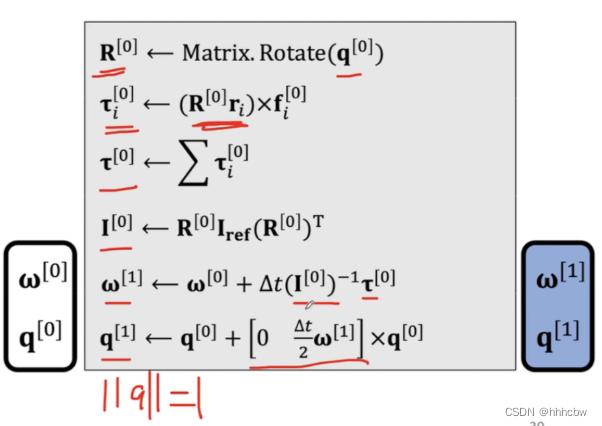
由于lab1中只考虑了重力,所以其力矩和角速度是不需要更新的,当然碰撞之后对于的角速度要更新。
粒子碰撞检测与响应
碰撞检测
我们可以使用 ϕ(x⃗)\\phi(\\vec{x})ϕ(x) 定义位于x⃗\\vec{x}x位置的粒子到一个曲面的有向距离,其符号由粒子位于曲面的内侧还是外侧确定。
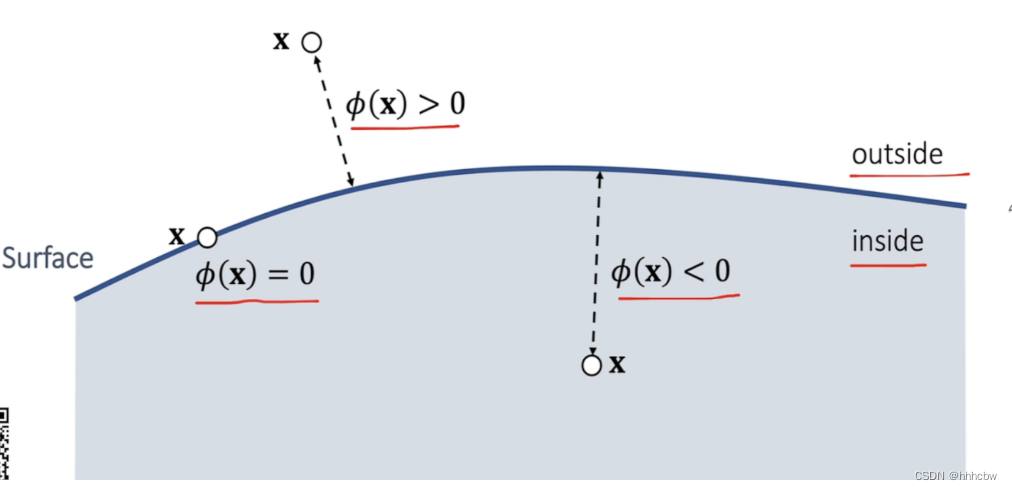
常见的 ϕ(x⃗)\\phi(\\vec{x})ϕ(x) 的实例
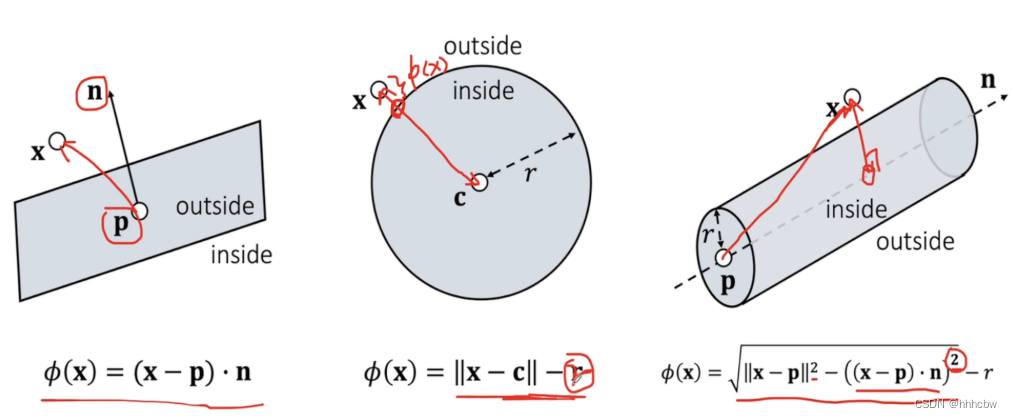
碰撞响应
Penalty Methods
Quadratic Penalty Method
一个 penalty 方法会在下一次更新中应用一次穿透力,即这次更新穿透还是发生了,我们在下一次更新时进行纠正。
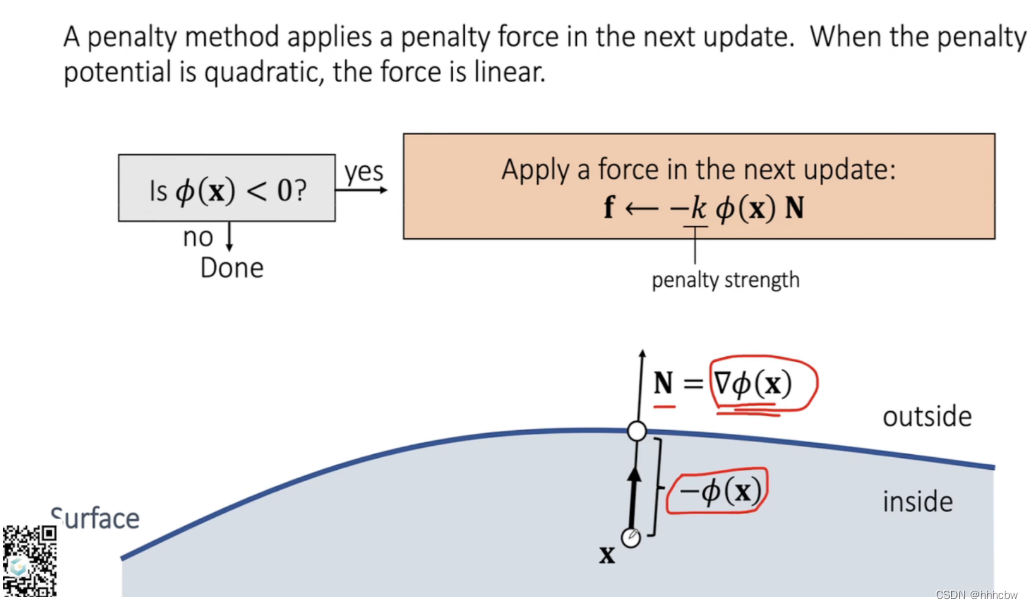
Quadratic Penalty Method with a Buffer
上一个方法的问题在于穿透已经实际产生了,我们可以加一个缓冲区,在穿透还未发生时阻止其产生。需要注意的 k 的大小设置很重要,如果 k 太小穿透仍会发生,而 k 过大会产生 overshooting 问题,即受到的穿透力过大导致物体飞出去。
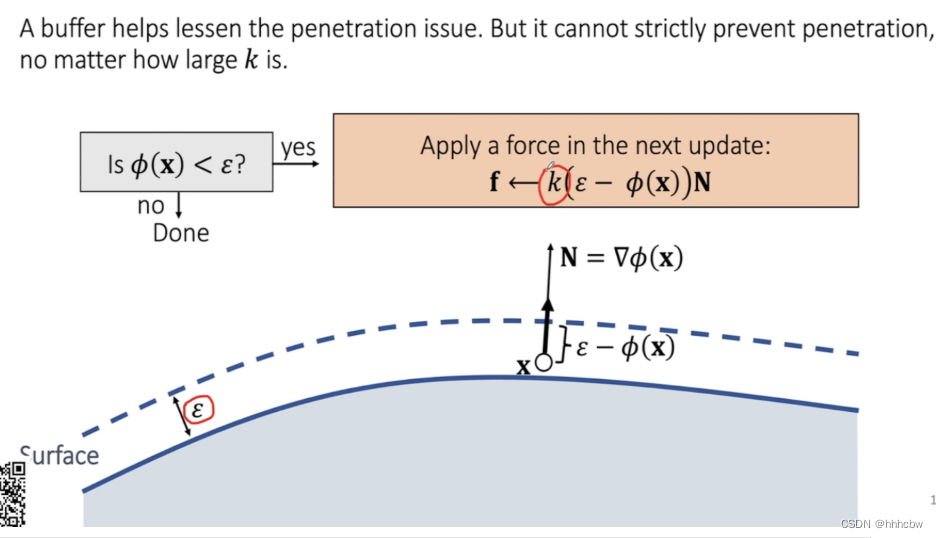
Log-Barrier Penalty Method
使用log-barrier penalty 能确保力足够大,但是仍存在overshooting问题,且需要保证 ϕ(x⃗)<0\\phi(\\vec{x})<0ϕ(x)<0 不会发生,否则会导致发生穿透越陷越深。
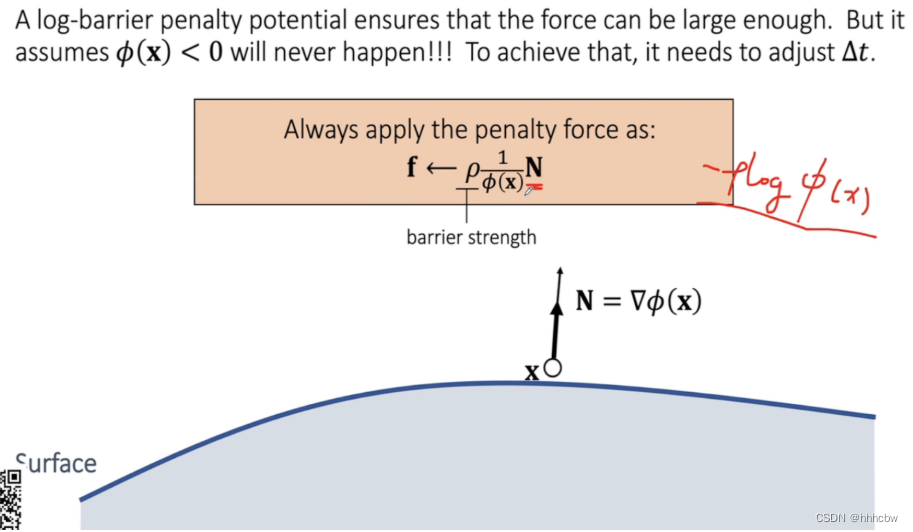
Impulse Method
Impulse 方法假设碰撞会立即改变位置与速度
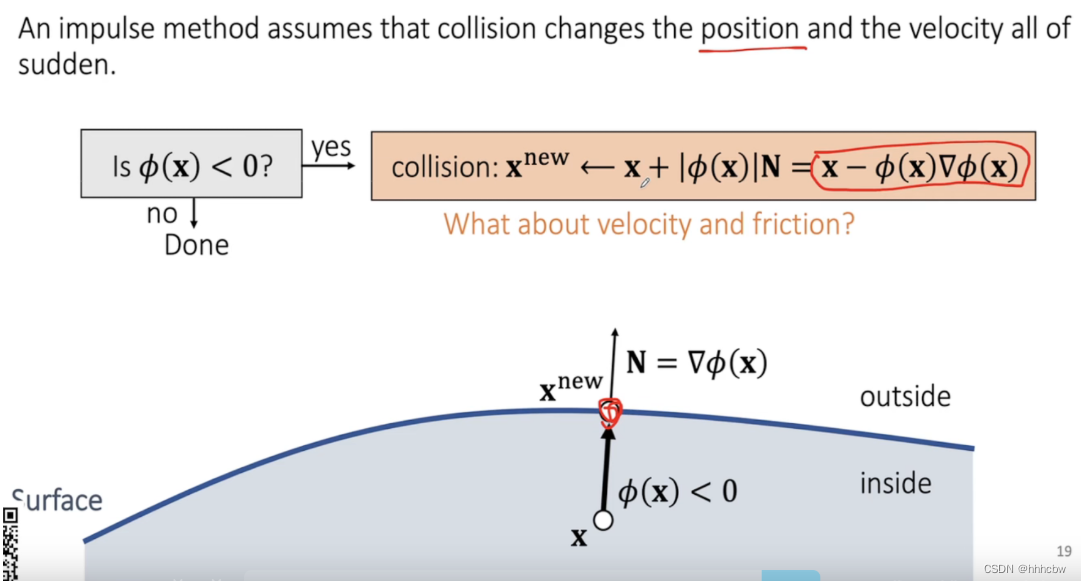

我们可以把当前速度看成与碰撞平面法向量相同的法向速度vN⃗\\vec{v_N}vN,以及相切的切向速度vT⃗\\vec{v_T}vT。对于法向速度,我们要将其反向且乘上一个摩擦系数,因为会有损耗,切向速度也要乘上摩擦系数。
而摩擦系数与新速度和旧速度之间的关系要满足 Coulomb’s law,因此 a 可以如上图求出。
刚体碰撞检测与响应
碰撞检测
与粒子的碰撞检测相同,刚体可以看作很多粒子组成的系统,那么我们就对所有粒子进行粒子的碰撞检测。
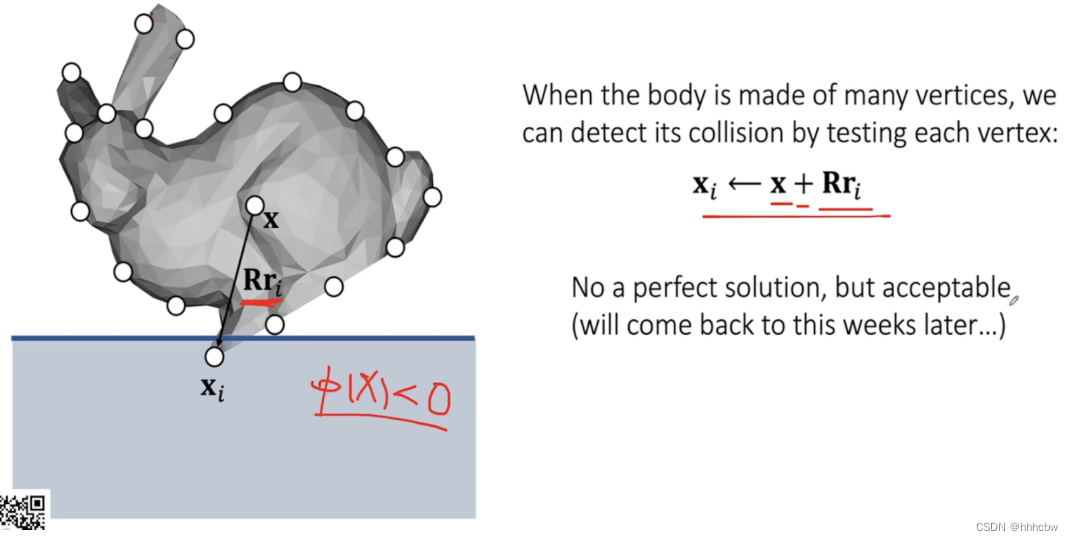
Impulse方法的碰撞响应
我们可以按照粒子的 Impulse 方法的碰撞响应来进行,但是我们不能直接对速度进行更新(按照老师的话其只是一个中间变量),因为我们对于速度的更新是分为平移速度和角速度的,我们要想办法转为对这两个量的更新。

向量叉乘可以转化为对应的矩阵乘向量

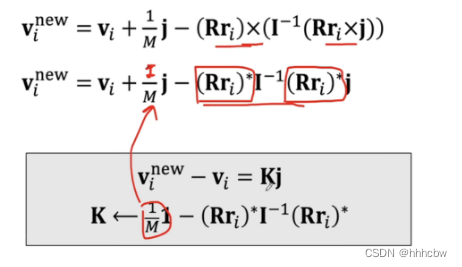
其整体流程如下
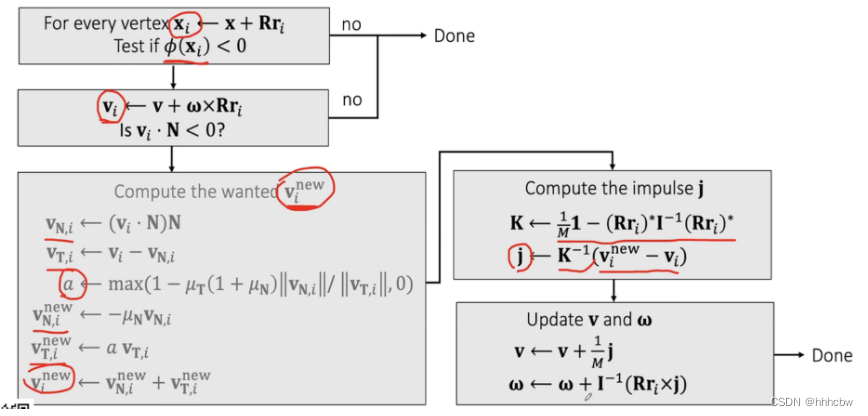
需要注意的是,我们要对所有碰撞的点求平均位置与平均速度来进行后续计算。这里不直接更新位置的原因是,这个问题是非线性的,之后会约束的章节讨论。
作业代码与提高项
Unity 2021.3.21f1c1
作业代码
using UnityEngine;
using System.Collections;
using System;public class Rigid_Bunny : MonoBehaviour
{bool launched = false;float dt = 0.015f;Vector3 v = new Vector3(0, 0, 0); // velocityVector3 w = new Vector3(0, 0, 0); // angular velocityfloat mass; // massMatrix4x4 I_ref; // reference inertiafloat linear_decay = 0.999f; // for velocity decayfloat angular_decay = 0.98f;float restitution = 0.5f; // for collisionfloat friction = 0.2f; Vector3 gravity = new Vector3(0.0f, -9.8f, 0.0f);// Use this for initializationvoid Start(){Mesh mesh = GetComponent<MeshFilter>().mesh;Vector3[] vertices = mesh.vertices;float m = 1;mass = 0;for (int i = 0; i < vertices.Length; i++){mass += m;float diag = m * vertices[i].sqrMagnitude;//diag = mv^2I_ref[0, 0] += diag;I_ref[1, 1] += diag;I_ref[2, 2] += diag;I_ref[0, 0] -= m * vertices[i][0] * vertices[i][0];I_ref[0, 1] -= m * vertices[i][0] * vertices[i][1];I_ref[0, 2] -= m * vertices[i][0] * vertices[i][2];I_ref[1, 0] -= m * vertices[i][1] * vertices[i][0];I_ref[1, 1] -= m * vertices[i][1] * vertices[i][1];I_ref[1, 2] -= m * vertices[i][1] * vertices[i][2];I_ref[2, 0] -= m * vertices[i][2] * vertices[i][0];I_ref[2, 1] -= m * vertices[i][2] * vertices[i][1];I_ref[2, 2] -= m * vertices[i][2] * vertices[i][2];}I_ref[3, 3] = 1;}Matrix4x4 Get_Cross_Matrix(Vector3 a)//得到向量a的叉乘矩阵{//Get the cross product matrix of vector aMatrix4x4 A = Matrix4x4.zero;A[0, 0] = 0;A[0, 1] = -a[2];A[0, 2] = a[1];A[1, 0] = a[2];A[1, 1] = 0;A[1, 2] = -a[0];A[2, 0] = -a[1];A[2, 1] = a[0];A[2, 2] = 0;A[3, 3] = 1;return A;}private Quaternion Add(Quaternion a, Quaternion b){a.x += b.x;a.y += b.y;a.z += b.z;a.w += b.w;return a;}private Matrix4x4 Matrix_subtraction(Matrix4x4 a, Matrix4x4 b){for (int i = 0; i < 4; ++i){for (int j = 0; j < 4; ++j){a[i, j] -= b[i, j];}}return a;}private Matrix4x4 Matrix_miltiply_float(Matrix4x4 a, float b){for (int i = 0; i < 4; ++i){for (int j = 0; j < 4; ++j){a[i, j] *= b;}}return a;}// In this function, update v and w by the impulse due to the collision with// a plane <P, N>void Collision_Impulse(Vector3 P, Vector3 N){Mesh mesh = GetComponent<MeshFilter>().mesh;Vector3[] vertices = mesh.vertices;Matrix4x4 R = Matrix4x4.Rotate(transform.rotation); // rotation matrixVector3 T = transform.position; // translation vectorVector3 sum = new Vector3(0, 0, 0); int collisionNum = 0; // number of collisionfor (int i = 0; i < vertices.Length; i++){Vector3 r_i = vertices[i];Vector3 Rri = R.MultiplyVector(r_i);Vector3 x_i = T + Rri;float d = Vector3.Dot(x_i - P, N);if (d < 0.0f) // collision occur{Vector3 v_i = v + Vector3.Cross(w, Rri);float v_N_size = Vector3.Dot(v_i, N);// check velocityif (v_N_size < 0.0f){sum += r_i;collisionNum++;}}}if (collisionNum == 0) return;Matrix4x4 I_rot = R * I_ref * R.transpose;Matrix4x4 I_inverse = I_rot.inverse; Vector3 r_collision = sum / (float)collisionNum; // virtual collision point(local coordination)Vector3 Rr_collision = R.MultiplyVector(r_collision);//Vector3 x_collision = T + Rr_collision; // virtual collision point(global coordination)Vector3 v_collision = v + Vector3.Cross(w, Rr_collision);// Compute the wanted v_NVector3 v_N = Vector3.Dot(v_collision, N) * N;Vector3 v_T = v_collision - v_N;Vector3 v_N_new = -1.0f * restitution * v_N;float a = Math.Max(1.0f - friction * (1.0f + restitution) * v_N.magnitude / v_T.magnitude, 0.0f);Vector3 v_T_new = a * v_T;Vector3 v_new = v_N_new + v_T_new;// Compute the impulse JMatrix4x4 Rri_star = Get_Cross_Matrix(Rr_collision);Matrix4x4 K = Matrix_subtraction(Matrix_miltiply_float(Matrix4x4.identity, 1.0f / mass),Rri_star * I_inverse * Rri_star);Vector3 J = K.inverse.MultiplyVector(v_new - v_collision);// Update v and w with impulse Jv = v + 1.0f / mass * J;w = w + I_inverse.MultiplyVector(Vector3.Cross(Rr_collision, J));}// Update is called once per framevoid Update(){//Game Controlif (Input.GetKey("r")){// return initial statetransform.position = new Vector3(0, 0.6f, 0);transform.eulerAngles = new Vector3(80, 0, 0);restitution = 0.5f;launched = false;Debug.Log("return to origin");}if (Input.GetKey("l")){v = new Vector3(5, 2, 0);w = new Vector3(0, 1, 0);launched = true;}if (launched){// Part I: Update velocitiesv += dt * gravity;v *= linear_decay;w *= angular_decay;// Part II: Collision ImpulseCollision_Impulse(new Vector3(0, 0.01f, 0), new Vector3(0, 1, 0));Collision_Impulse(new Vector3(2, 0, 0), new Vector3(-1, 0, 0));// Part III: Update position & orientationVector3 x_0 = transform.position;Quaternion q_0 = transform.rotation;//Update linear statusVector3 x = x_0 + dt * v;//Update angular statusVector3 dw = 0.5f * dt * w;Quaternion qw = new Quaternion(dw.x, dw.y, dw.z, 0.0f);Quaternion q = Add(q_0, qw * q_0);// Part IV: Assign to the objecttransform.position = x;transform.rotation = q;}}
}
运行结果
提高项
Shape Matching的思想是将刚体看作粒子系统,针对每个粒子有其自己的位置与速度,分别对每个粒子进行更新。之后对更新后的粒子,使用刚体的约束进行修复。这里的刚体约束就是每个粒子的位置,由质心坐标与其相对于质心的矢量以及旋转矩阵R有关,即xi⃗=c⃗+Rri⃗\\vec{x_i}=\\vec{c}+R\\vec{r_i}xi=c+Rri。要让约束后的位置和初始位置 yiy_iyi 尽可能接近。
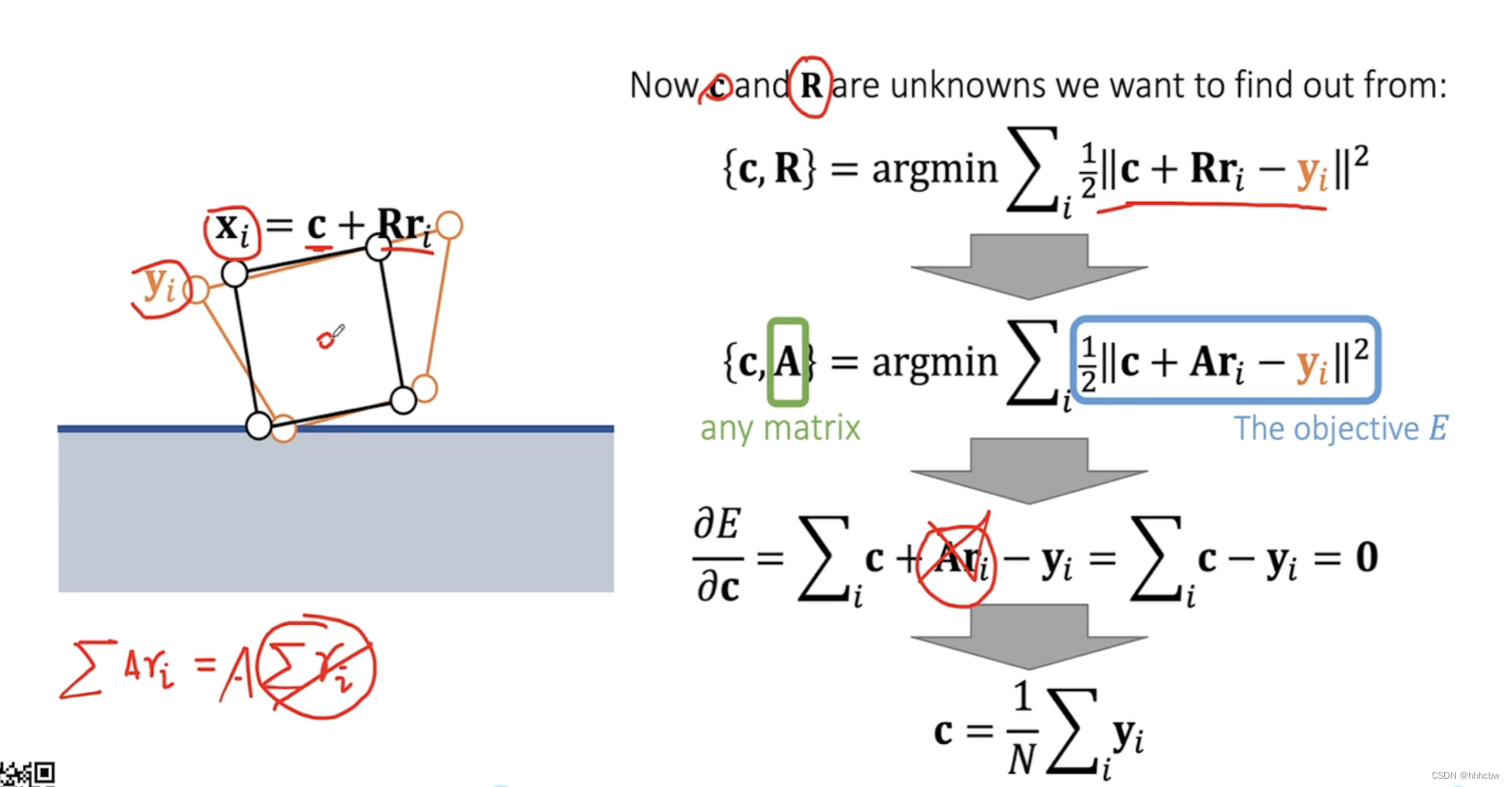
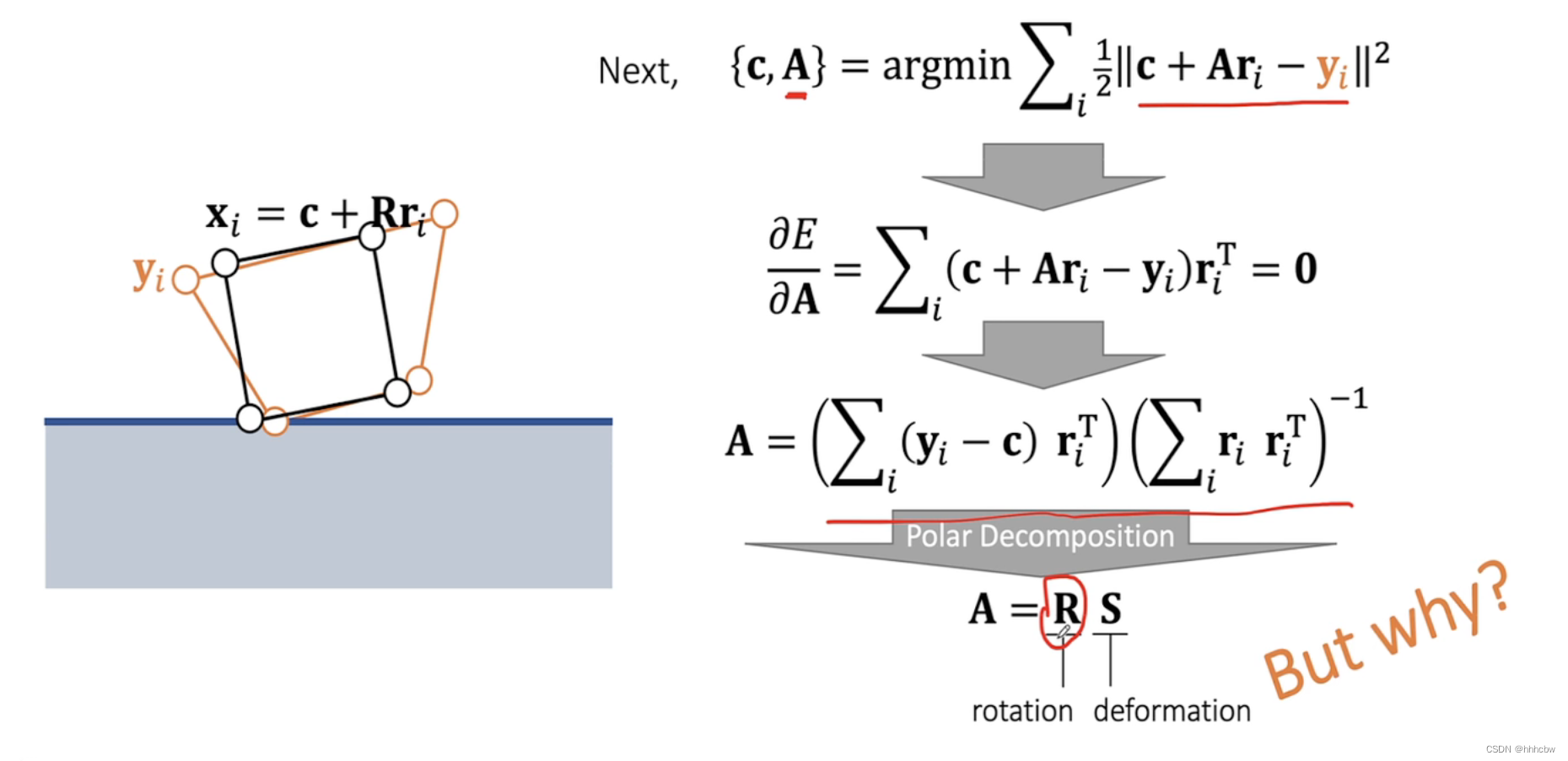
其更新过程如下
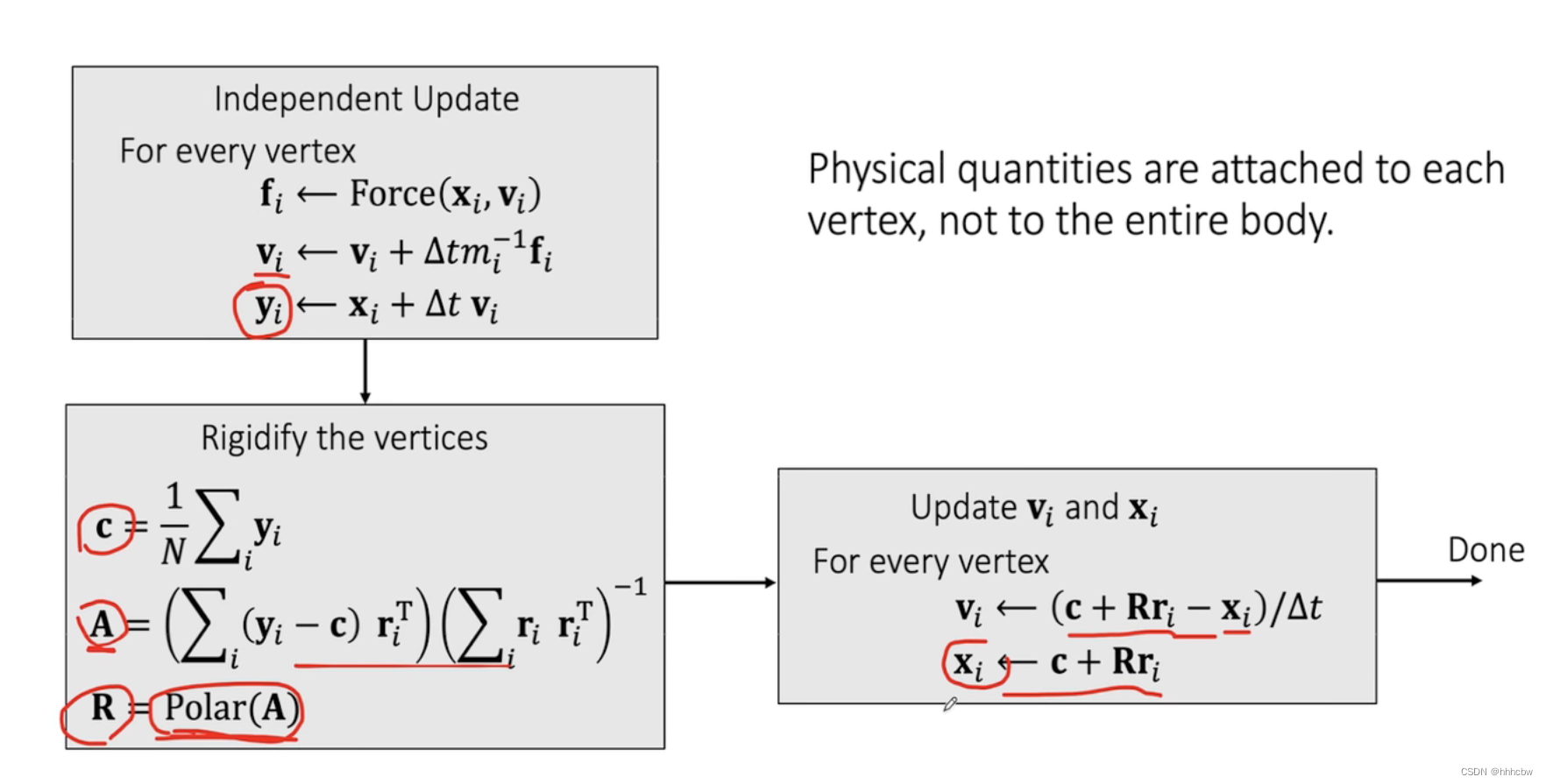
对于粒子的碰撞响应,采用之前impulse的方法,但是直接更新其法向速度和切向速度。
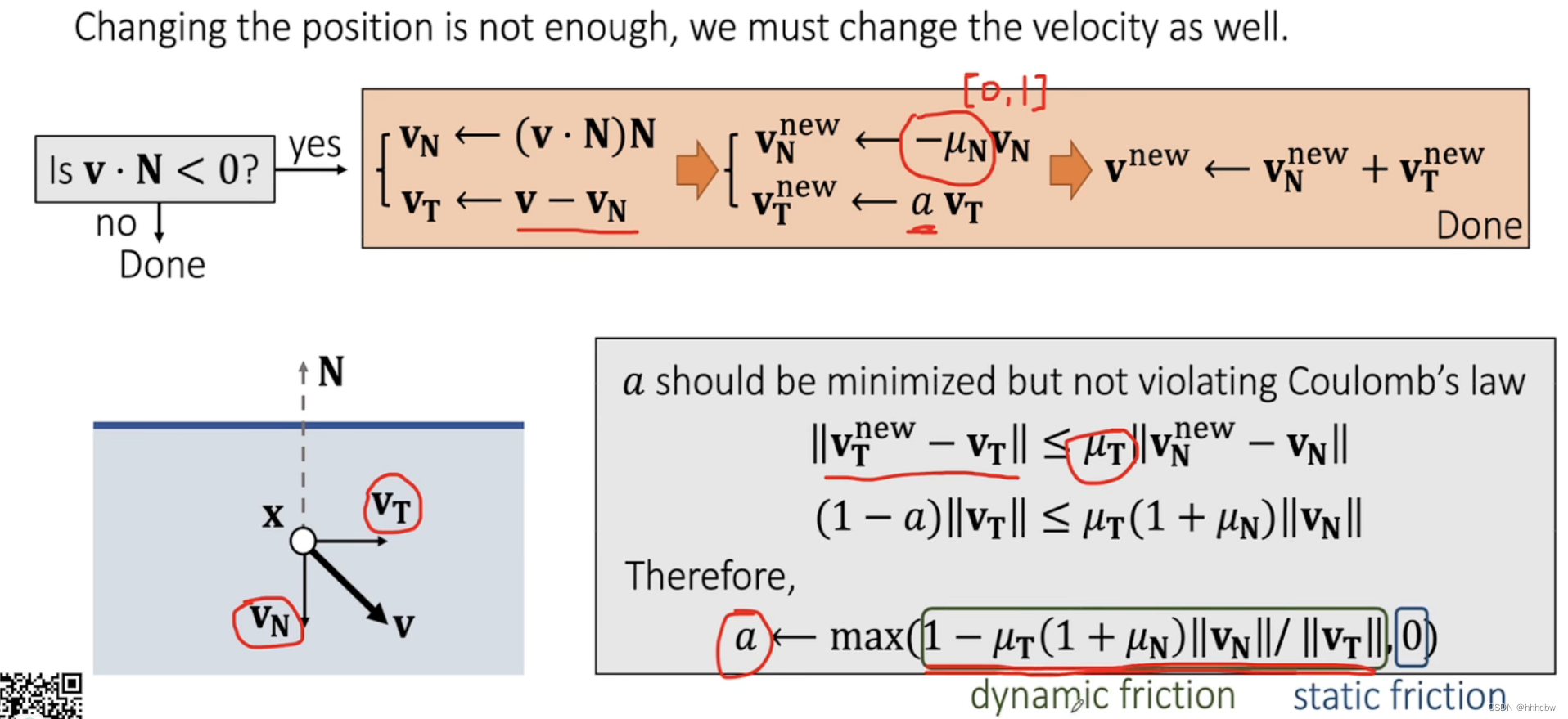
代码如下
using System;
using System.Collections;
using System.Collections.Generic;
using UnityEngine;public class Rigid_Bunny_by_Shape_Matching : MonoBehaviour
{public bool launched = false;Vector3[] X;Vector3[] Q;Vector3[] V;Vector3[] Y;Matrix4x4 QQt = Matrix4x4.zero;Vector3 gravity = new Vector3(0, -9.8f, 0);float linear_decay = 0.999f; // for velocity decayfloat restitution = 5.0f; // for collisionfloat friction = 0.5f;// Start is called before the first frame updatevoid Start(){Mesh mesh = GetComponent<MeshFilter>().mesh;V = new Vector3[mesh.vertices.Length];Y = mesh.vertices;X = mesh.vertices;Q = mesh.vertices;//Centerizing Q.Vector3 c = Vector3.zero;for (int i = 0; i < Q.Length; i++)c += Q[i];c /= Q.Length;//Debug.Log(c);for (int i = 0; i < Q.Length; i++)Q[i] -= c;//Get QQ^t ready.for (int i = 0; i < Q.Length; i++){QQt[0, 0] += Q[i][0] * Q[i][0];QQt[0, 1] += Q[i][0] * Q[i][1];QQt[0, 2] += Q[i][0] * Q[i][2];QQt[1, 0] += Q[i][1] * Q[i][0];QQt[1, 1] += Q[i][1] * Q[i][1];QQt[1, 2] += Q[i][1] * Q[i][2];QQt[2, 0] += Q[i][2] * Q[i][0];QQt[2, 1] += Q[i][2] * Q[i][1];QQt[2, 2] += Q[i][2] * Q[i][2];}QQt[3, 3] = 1;for (int i = 0; i < X.Length; i++)V[i][0] = 4.0f;//Debug.Log(transform.position);// transform X from local coordination to global coordinationUpdate_Mesh(transform.position, Matrix4x4.Rotate(transform.rotation), 0);transform.position = Vector3.zero;transform.rotation = Quaternion.identity;//Debug.Log(transform.position);}// Polar Decomposition that returns the rotation from F.Matrix4x4 Get_Rotation(Matrix4x4 F){Matrix4x4 C = Matrix4x4.zero;for (int ii = 0; ii < 3; ii++)for (int jj = 0; jj < 3; jj++)for (int kk = 0; kk < 3; kk++)C[ii, jj] += F[kk, ii] * F[kk, jj];Matrix4x4 C2 = Matrix4x4.zero;for (int ii = 0; ii < 3; ii++)for (int jj = 0; jj < 3; jj++)for (int kk = 0; kk < 3; kk++)C2[ii, jj] += C[ii, kk] * C[jj, kk];float det = F[0, 0] * F[1, 1] * F[2, 2] +F[0, 1] * F[1, 2] * F[2, 0] +F[1, 0] * F[2, 1] * F[0, 2] -F[0, 2] * F[1, 1] * F[2, 0] -F[0, 1] * F[1, 0] * F[2, 2] -F[0, 0] * F[1, 2] * F[2, 1];float I_c = C[0, 0] + C[1, 1] + C[2, 2];float I_c2 = I_c * I_c;float II_c = 0.5f * (I_c2 - C2[0, 0] - C2[1, 1] - C2[2, 2]);float III_c = det * det;float k = I_c2 - 3 * II_c;Matrix4x4 inv_U = Matrix4x4.zero;if (k < 1e-10f){float inv_lambda = 1 / Mathf.Sqrt(I_c / 3);inv_U[0, 0] = inv_lambda;inv_U[1, 1] = inv_lambda;inv_U[2, 2] = inv_lambda;}else{float l = I_c * (I_c * I_c - 4.5f * II_c) + 13.5f * III_c;float k_root = Mathf.Sqrt(k);float value = l / (k * k_root);if (value < -1.0f) value = -1.0f;if (value > 1.0f) value = 1.0f;float phi = Mathf.Acos(value);float lambda2 = (I_c + 2 * k_root * Mathf.Cos(phi / 3)) / 3.0f;float lambda = Mathf.Sqrt(lambda2);float III_u = Mathf.Sqrt(III_c);if (det < 0) III_u = -III_u;float I_u = lambda + Mathf.Sqrt(-lambda2 + I_c + 2 * III_u / lambda);float II_u = (I_u * I_u - I_c) * 0.5f;float inv_rate, factor;inv_rate = 1 / (I_u * II_u - III_u);factor = I_u * III_u * inv_rate;Matrix4x4 U = Matrix4x4.zero;U[0, 0] = factor;U[1, 1] = factor;U[2, 2] = factor;factor = (I_u * I_u - II_u) * inv_rate;for (int i = 0; i < 3; i++)for (int j = 0; j < 3; j++)U[i, j] += factor * C[i, j] - inv_rate * C2[i, j];inv_rate = 1 / III_u;factor = II_u * inv_rate;inv_U[0, 0] = factor;inv_U[1, 1] = factor;inv_U[2, 2] = factor;factor = -I_u * inv_rate;for (int i = 0; i < 3; i++)for (int j = 0; j < 3; j++)inv_U[i, j] += factor * U[i, j] + inv_rate * C[i, j];}Matrix4x4 R = Matrix4x4.zero;for (int ii = 0; ii < 3; ii++)for (int jj = 0; jj < 3; jj++)for (int kk = 0; kk < 3; kk++)R[ii, jj] += F[ii, kk] * inv_U[kk, jj];R[3, 3] = 1;return R;}// Update the mesh vertices according to translation c and rotation R.// It also updates the velocity.void Update_Mesh(Vector3 c, Matrix4x4 R, float inv_dt){for (int i = 0; i < Q.Length; i++){Vector3 x = (Vector3)(R * Q[i]) + c;V[i] = (x - X[i]) * inv_dt;X[i] = x;}Mesh mesh = GetComponent<MeshFilter>().mesh;mesh.vertices = X;}void Collision(float inv_dt){Vector3 P = new Vector3(0, 0.01f, 0);Vector3 N = new Vector3(0, 1, 0);// check collision with groundfor (int i = 0; i < X.Length; i++){float d = Vector3.Dot(X[i] - P, N);if (d < 0.0f) // collision occur{float v_N_size = Vector3.Dot(V[i], N);// check velocityif (v_N_size < 0.0f){Vector3 v_N = v_N_size * N;Vector3 v_T = V[i] - v_N;Vector3 v_N_new = -1.0f * restitution * v_N;float a = Math.Max(1.0f - friction * (1.0f + restitution) * v_N.magnitude / v_T.magnitude, 0.0f);Vector3 v_T_new = a * v_T;V[i] = v_N_new + v_T_new;}}}P = new Vector3(2.01f, 0, 0);N = new Vector3(-1, 0, 0);// check collsion with wallfor (int i = 0; i < X.Length; i++){float d = Vector3.Dot(X[i] - P, N);if (d < 0.0f) // collision occur{float v_N_size = Vector3.Dot(V[i], N);// check velocityif (v_N_size < 0.0f){Vector3 v_N = v_N_size * N;Vector3 v_T = V[i] - v_N;Vector3 v_N_new = -1.0f * restitution * v_N;float a = Math.Max(1.0f - friction * (1.0f + restitution) * v_N.magnitude / v_T.magnitude, 0.0f);Vector3 v_T_new = a * v_T;V[i] = v_N_new + v_T_new;}}}}Matrix4x4 Vector3_mul_Vector3T(Vector3 v1, Vector3 v2){Matrix4x4 res = Matrix4x4.zero;res[3, 3] = 1.0f;for (int i = 0; i < 3; i++)for (int j = 0; j < 3; j++){res[i, j] = v1[i] * v2[j];}return res;}Matrix4x4 Matrix4x4_add_Matrix4x4(Matrix4x4 m1, Matrix4x4 m2){Matrix4x4 res = Matrix4x4.zero;for (int i = 0; i < 3; i++)for (int j = 0; j < 3; j++){res[i, j] = m1[i, j] + m2[i, j];}return res;}// Update is called once per framevoid Update(){//Game Controlif (Input.GetKey("r")){// return initial statelaunched = false;for (int i = 0; i < V.Length; i++){V[i] = new Vector3(4.0f, 0.0f, 0.0f);}Update_Mesh(new Vector3(0, 0.6f, 0),Matrix4x4.Rotate(Quaternion.Euler(new Vector3(80, 0, 0))), 0);Debug.Log("return to origin");}if (Input.GetKey("l")){launched = true;for (int i = 0; i < V.Length; i++){V[i] = new Vector3(5.0f, 2.0f, 0.0f);}}if (!launched)return;float dt = 0.015f;//Step 1: run a simple particle system.for (int i = 0; i < V.Length; i++){V[i] = V[i] + dt * gravity;V[i] = V[i] * linear_decay;}//Step 2: Perform simple particle collision.Collision(1 / dt);// Step 3: Use shape matching to get new translation c and // new rotation R. Update the mesh by c and R.//Shape Matching (translation)for (int i = 0; i < V.Length; i++){Y[i] = X[i] + V[i] * dt;}Vector3 c = Vector3.zero;for (int i = 0; i < Y.Length; i++){c = c + Y[i];}c = c / Y.Length;//Shape Matching (rotation)Matrix4x4 A = Matrix4x4.zero;for (int i = 0; i < Y.Length; i++){A = Matrix4x4_add_Matrix4x4(A, Vector3_mul_Vector3T(Y[i] - c, Q[i]));}A[3, 3] = 1.0f;A = A * QQt.inverse;Matrix4x4 R = Get_Rotation(A);//Update_Mesh(c, R, 1/dt);Update_Mesh(c, R, 1 / dt);}
}运行结果



